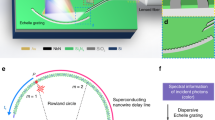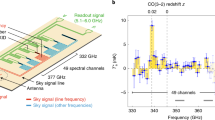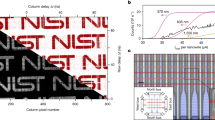Abstract
Far-infrared spectroscopy can reveal secrets of galaxy evolution and heavy-element enrichment throughout cosmic time, prompting astronomers worldwide to design cryogenic space telescopes for far-infrared spectroscopy. The most challenging aspect is a far-infrared detector that is both exquisitely sensitive (limited by the zodiacal-light noise in a narrow wavelength band, λ/Δλ ~1,000) and array-able to tens of thousands of pixels. We present the quantum capacitance detector, a superconducting device adapted from quantum computing applications in which photon-produced free electrons in a superconductor tunnel into a small capacitive island embedded in a resonant circuit. The quantum capacitance detector has an optically measured noise equivalent power below 10−20 W Hz−1/2 at 1.5 THz, making it the most sensitive far-infrared detector ever demonstrated. We further demonstrate individual far-infrared photon counting, confirming the excellent sensitivity and suitability for cryogenic space astrophysics.
This is a preview of subscription content, access via your institution
Access options
Access Nature and 54 other Nature Portfolio journals
Get Nature+, our best-value online-access subscription
$29.99 / 30 days
cancel any time
Subscribe to this journal
Receive 12 digital issues and online access to articles
$119.00 per year
only $9.92 per issue
Buy this article
- Purchase on Springer Link
- Instant access to full article PDF
Prices may be subject to local taxes which are calculated during checkout






Similar content being viewed by others
References
Madau, P. & Dickinson, M. Cosmic star-formation history. Annu. Rev. Astron. Astr. 52, 415–486 (2014).
Nakagawa, T. et al. The next-generation infrared astronomy mission SPICA under the new framework. Proc. SPIE 9143, 91431I (2014).
Bradford, C. M. et al. A cryogenic space telescope for far-infrared astrophysics: a vision for NASA in the 2020 decade. Preprint at https://arxiv.org/abs/1505.05551 (2015).
Shaw, M. D., Bueno, J., Day, P. K., Bradford, C. M. & Echternach, P. M. Quantum capacitance detector: a pair-breaking radiation detector based on the single Cooper-pair box. Phys. Rev. B 79, 144511 (2009).
Bueno, J., Shaw, M. D., Day, P. K. & Echternach, P. M. Proof of concept of the quantum capacitance detector. Appl. Phys. Lett. 96, 103503 (2010).
Bueno, J., Llombart, N., Day, P. K. & Echternach, P. M. Optical characterization of the quantum capacitance detector at 200 μm. Appl. Phys. Lett. 99, 173503 (2011).
Stone, K. J. et al. Real time quasiparticle tunneling measurements on an illuminated quantum capacitance detector. Appl. Phys. Lett. 100, 263509 (2012).
Echternach, P. M. et al. Photon shot noise limited detection of terahertz radiation using a quantum capacitance detector. Appl. Phys. Lett. 103, 053510 (2013).
Wilson, C. M. & Prober, D. E. Quasiparticle number fluctuations in superconductors. Phys. Rev. B 69, 094524 (2004).
Kozorezov, A. G. et al. Quasiparticle-phonon downconversion in nonequilibrium superconductors. Phys. Rev. B 61, 11807–11819 (2000).
Wang, C. et al. Measurement and control of quasiparticle dynamics in a superconducting qubit. Nat. Commun. 5, 5836 (2014).
Day, P. K., LeDuc, H. G., Mazin, B. A., Vayonakis, A. & Zmuidzinas, J. Broadband superconducting detector suitable for use in large arrays. Nature 425, 817–821 (2003).
De Visser, P. J., Baselmans, J. J. A., Bueno, J., Llombart, N. & Klapwijk, T. M. Fluctuations in the electron system of a superconductor exposed to a photon flux. Nat. Commun. 5, 3130 (2014).
De Visser, P. J. et al. Number fluctuations of sparse quasiparticles in a superconductor. Phys. Rev. Lett. 106, 167004 (2011).
Machlup, S. Noise in semiconductors: spectrum of a two-parameter random signal. J. Appl. Phys. 25, 341–343 (1954).
Guillaume, A., Schneiderman, J. F., Delsing, P., Bozler, H. M. & Echternach, P. M. Free evolution of superposition states in a single Cooper pair box. Phys. Rev. B 69, 132504 (2004).
Persky, M. J. Review of black surfaces for space-borne infrared systems. Rev. Sci. Instrum. 70, 2193–2217 (1999).
Benford, D. J., Gaidis, M. C. & Kooi, J. W. Optical properties of Zitex in the infrared to submillimeter. Appl. Opt. 42, 5118–5122 (2003).
Acknowledgements
We thank R. E. Muller for performing the electron beam lithography and D. W. Wilson for the design and fabrication of the Fresnel lens array. This work was performed at the Jet Propulsion Laboratory, California Institute of Technology, under a contract with the National Aeronautics and Space Administration. US Government sponsorship acknowledged.
Author information
Authors and Affiliations
Contributions
P.M.E designed and fabricated the devices, performed the experiments, analysed the data and wrote the paper. C.M.B. devised the experiment goals and some experiment protocols. T.R. performed simulations of the interaction of radiation with the devices. B.J.P. contributed to the data analysis and the calculation of the radiation incident on the devices. All authors contributed to preparing the paper.
Corresponding author
Ethics declarations
Competing interests
The authors declare no competing financial interests
Additional information
Publisher’s note: Springer Nature remains neutral with regard to jurisdictional claims in published maps and institutional affiliations.
Electronic supplementary material
Supplementary Information
Supplementary Figure 1, Supplementary Table 1, Supplementary Text and Supplementary References
Rights and permissions
About this article
Cite this article
Echternach, P.M., Pepper, B.J., Reck, T. et al. Single photon detection of 1.5 THz radiation with the quantum capacitance detector. Nat Astron 2, 90–97 (2018). https://doi.org/10.1038/s41550-017-0294-y
Received:
Accepted:
Published:
Issue Date:
DOI: https://doi.org/10.1038/s41550-017-0294-y
This article is cited by
-
Superconducting tunnel junctions with layered superconductors
Quantum Frontiers (2024)
-
High-throughput terahertz imaging: progress and challenges
Light: Science & Applications (2023)
-
A superconductor free of quasiparticles for seconds
Nature Physics (2022)
-
Reducing Frequency Scatter in Large Arrays of Superconducting Resonators with Inductor Line Width Control
Journal of Low Temperature Physics (2022)
-
Nanobolometer with ultralow noise equivalent power
Communications Physics (2019)



